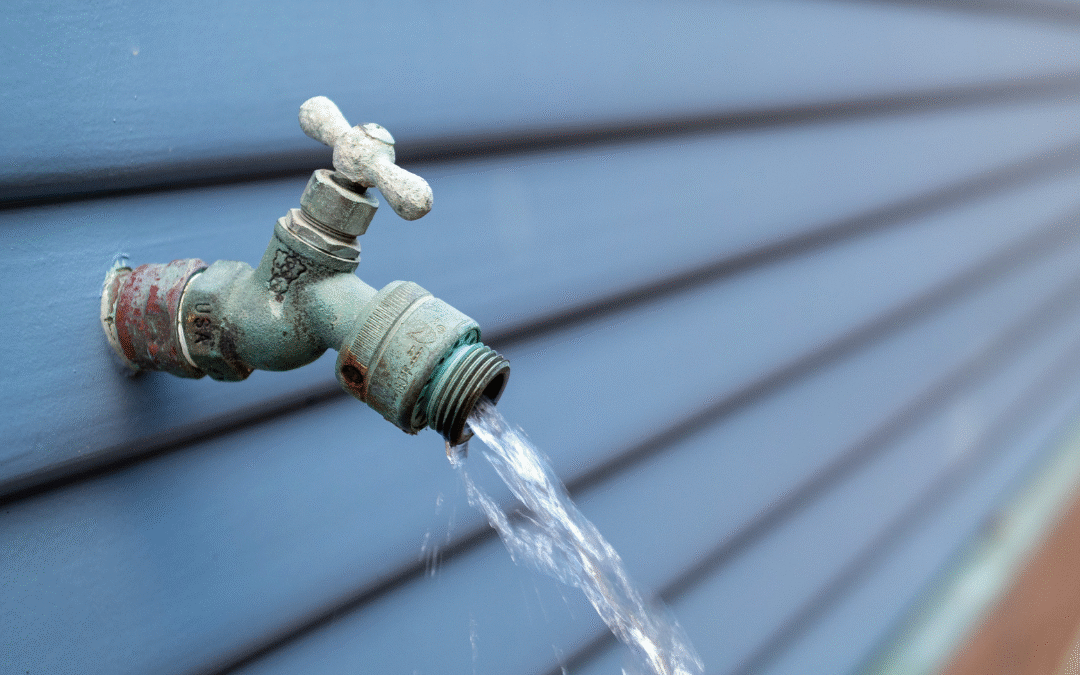Avoid common mistakes that lead to frozen outdoor spigots and burst plumbing inside walls
As the colder months approach in Northern Kentucky and Greater Cincinnati, homeowners often think about furnaces, gutters, and roof preparation. But one simple step that’s frequently overlooked—yet can save you from thousands of dollars in damage—is shutting off and draining your outdoor faucets correctly. A frozen spigot doesn’t just stop your garden hose; it can burst the pipe inside your wall, leading to costly leaks and water damage.
Table of Contents
Why Outdoor Faucets Freeze So Easily
Outdoor faucets, also called hose bibs or spigots, are directly exposed to cold air. Even if you disconnect the hose, any water trapped inside the faucet or connecting pipe can freeze and expand. When that happens, the pressure often causes the pipe inside your wall or basement to crack, leading to a hidden leak that might not show up until spring.
The risk is especially high in our region, where winter temperatures often dip below freezing for days at a time. Proper shut-off is your best defense.
Step 1: Disconnect and Drain the Hose
The first and most important step is to remove your garden hose from the spigot. Hoses trap water inside the faucet, increasing the risk of freezing. After disconnecting, make sure to store the hose indoors or in a shed so it doesn’t crack from the cold.
Many homeowners stop at this step, but that’s where problems can start. Just removing the hose doesn’t protect the pipe behind the faucet—you need to go further.
Step 2: Locate and Close the Interior Shut-Off Valve
Most homes in Greater Cincinnati and Northern Kentucky have a dedicated shut-off valve for each outdoor faucet. These are usually located in the basement, crawl space, or utility room. Turning this valve clockwise closes the water supply to the outdoor spigot.
If your home doesn’t have a dedicated shut-off, it may be time to upgrade. Installing one is a simple, affordable plumbing project that gives you much better protection.
Step 3: Drain Any Remaining Water
After shutting off the interior valve, go back outside and open the spigot. Let any remaining water drain out completely. This step is critical—water trapped in the faucet or pipe is what freezes and causes damage.
Some faucets also have a small drain cap inside near the shut-off valve. Opening this will help clear any leftover water from the pipe.
Step 4: Add Extra Protection if Needed
If your outdoor faucets aren’t frost-proof, or if you live in an older home, consider adding insulated faucet covers. These inexpensive covers act as an extra barrier against freezing temperatures.
For homeowners who want maximum protection, frost-free spigots are another smart upgrade. These extend the shut-off mechanism inside your warm home rather than leaving it exposed outside.
Common Mistakes to Avoid
Many homeowners unknowingly skip key steps. Here are the most common mistakes:
- Leaving the hose connected all winter.
- Forgetting to shut off the interior valve.
- Not draining the faucet after shutting off the water.
- Assuming newer homes don’t need this protection.
- Ignoring slow drips or leaks before winter sets in.
Each of these oversights can turn into a major plumbing repair once the freeze-thaw cycle begins.
Protect Your Home with Professional Plumbing Help
Taking 10 minutes to shut off your outdoor faucets the right way can prevent thousands of dollars in damage. But if you’re unsure whether your spigots are frost-free, or if you don’t have dedicated shut-off valves, it’s worth calling in the experts.
At A+ Services, we’ve been helping homeowners across Covington, Florence, Independence, and the Greater Cincinnati area prepare their plumbing for winter for decades. Our licensed plumbers can inspect your outdoor faucets, install proper shut-offs, and make sure your home is ready for freezing weather.
Don’t wait until a frozen spigot floods your basement. Schedule your winter plumbing inspection with A+ Services today and enjoy peace of mind all season long.

